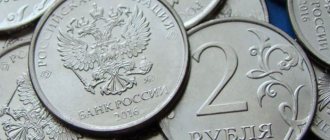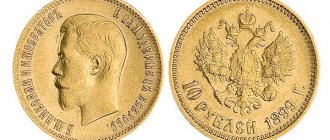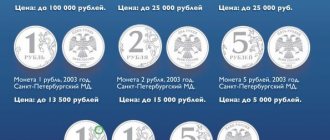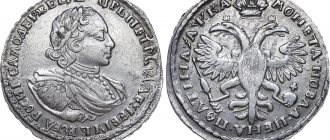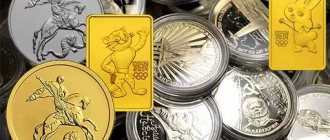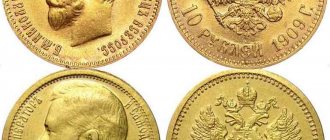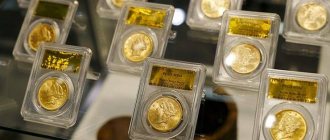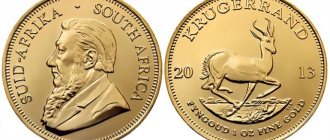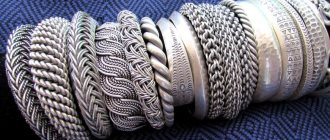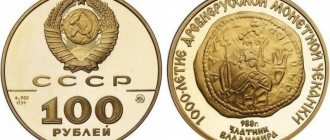Home > Articles
In this article, we have collected the rarest and most valuable modern circulating coins of Russia in denomination of 1 ruble, which were minted from 1997 to the present. These are expensive varieties, mint errors and defective banknotes, the cost of which is sometimes comparable to gold and silver coins.
1 ruble 1999
In 1999, two types of one-ruble coins were put into circulation, both commemorative and regular. A typical ruble is not rare, regardless of the mint; even in perfect condition, such a coin costs no more than 30 rubles.
But the anniversary coin is already more interesting, both from an aesthetic point of view and financially. The coin is dedicated to A.S. Pushkin. It was minted at both mints, both MMD and SPMD. This coin is quite common, but in perfect condition it is no longer so easy to find. Therefore, collectors are willing to pay 500-600 rubles for it. By the way, it is important for numismatists to have both Moscow and St. Petersburg coins in the collection.
How much do rare varieties cost?
Coins of the same year of issue and with the same mark of the same mint, but having slight differences, are called varieties. Some banknotes may not have varieties, while others have many. Among the varieties there are ordinary (common), infrequent and rare. The cost of the most valuable varieties can reach several tens of thousands of rubles.
Let's look at the most popular and expensive varieties of 1-ruble coins:
1 ruble 1997 MMD with wide edging
The 1997 edition with the letters “MMD” has two edging options. The edge (protruding edge) can be narrow or wide. The option with a wide edging is very rare. The cost of this variety reaches 6 thousand rubles.
The easiest way to distinguish the width of the edging is by looking at the reverse (the side with the floral design). Many elements of the floral ornament are hidden under the wide edging (primarily the edge of the leaf at the top, but it is also clearly visible from other elements). See the differences between narrow and wide edges in the photo:
1 ruble 1998 MMD with increased edging
The 1998 release of the MMD also has two varieties, differing in the width of the edge. A narrow edge is possible, as well as an enlarged one. But it’s difficult to call it wide; rather, we are talking about a medium-sized edging. If the edging is increased, then the price of the coin will increase to 3 thousand rubles.
The enlarged edging can be identified by the top leaf on the reverse. If there is no groove between the leaf and the edge, then the edge is enlarged (medium size).
1 ruble 2007 MMD with sheet without slots
The 2007 ruble with the symbol of the Moscow Mint (MMD) has two types of reverse. They differ in the notches on the upper leaf. A rare variety includes an image with a leaf without notches; another feature of this option is the symmetrical arrangement of the petals. This option is estimated at 300-500 rubles.
There are other rare and valuable varieties, but searching for them will require special skills and equipment to enlarge images and measure them. For those who are not deterred by this, we advise you to familiarize yourself with Alexander Stashkin’s catalog of varieties of coins from the Bank of Russia, which today is one of the most authoritative in the numismatic community.
1 ruble 2001
In 2001, only anniversary 1 ruble coins were issued - in honor of the 20th anniversary of the CIS. Regular rubles did not officially enter circulation this year. But many years later, ordinary rubles from 2001 still surfaced. Namely 1 ruble 2001 MMD. Only a few have held or seen this coin. This is more of a mythical coin than a real one. They say that they were allegedly included in the 2002 sets by mistake, but this is not certain.
According to preliminary estimates, such a coin costs more than 500,000 rubles, but its real value can only be determined by an auction and many examinations.
The St. Petersburg coin was never found, but who knows, maybe someday it will emerge from the bottom of the Niva.
As for the anniversary CIS, it is not rare, but if you have it in perfect condition, then it can be sold for 200 rubles.
Rare 1-ruble coins of modern Russia
Almost a quarter of a century has passed since the denomination. During this period, many 1 ruble coins appeared, very interesting and unusual in numismatic terms. In our review, we will ignore varieties that are difficult to identify (for example, 1 ruble 2010, in accordance with the variety catalog, has a couple of valuable varieties on the obverse, but only an expert can identify them), but we will talk about those that are easy to identify.
It should be said that any modern coins of the Russian Federation from the early years of issue, starting from 1997, in stamp shine without mechanical defects, are already worth above their face value. Sometimes even much more expensive. The reason is clear: those who recently started collecting Russian yearbooks want to put perfect coins in the album, but you can’t easily get them in change. Over the two decades that it has been in circulation, the bulk of the money has become very worn out and has long lost its original shine.
1 ruble 1997 MMD
Wide edge with step (left), flat wide edge (center), regular coin (right)
However, worn ruble coins can be expensive if they are a rare variety that is in high demand among collectors. For Moscow rubles with the date “1997” this variety is called “wide edge”. It is difficult to confuse a coin with such an edge with a regular one, even in appearance. But it’s easier to focus on the main sign. An ordinary coin has a gap between the edging and the top sheet of the floral ornament. In valuable specimens, this sheet extends deep under the edge. There are two varieties of “wide edge”: with and without a step. A edging without a step is considered rarer and is valued at a higher price. It should be noted that the coins of St. Petersburg have a visually wider edging than those of Moscow, but the SPMD rubles of 1997 are not rare.
1 ruble 1998 MMD
Wide edge (center) and regular coin (right)
The “wide edge” is also present on the 1998 MMD ruble coins, but there it is less pronounced. Here you should examine the coin under magnification. The sign is the same: on a regular coin there is a gap between the edge and the top sheet, but on a rare coin the kat and the sheet are in contact. Any type of “wide edge” 1997-1998. costs several thousand, but the specific price depends on the degree of preservation of the specimen. Moscow rubles also have a lesser-known variety, on which the MMD monogram is located below. However, in collecting circles it is considered infrequent rather than rare, so it will not be possible to get rich on such a ruble, although it is worth more than its face value.
1 ruble 2000 SPMD
Test coin SPMD (2000)
The Bank of Russia in 1999 decided that the already minted coins with the dates “1997” and “1998” were quite sufficient for circulation, so some denominations from the line were not minted en masse at all, while for others the order for minting was reduced. Ruble coins with the date “1999” are rarely found in circulation, but if you carefully examine your change, you can catch them. It was a different matter in 2000, when orders for rubles were not received for either MMD or SPMD. However, the mints were ready for minting. This is evidenced by the trial ruler of the St. Petersburg Court with the date “2000”. Numismatists learned about the existence of these coins almost two decades after they were minted, and there is still little information about them. However, it is known that these are originals, and even reliable photographs of them are available.
1 ruble 2001 MMD
The rarest MMD coin (2001)
We can say that it was with this ruble that the pursuit of rarities began, when Internet pages everywhere called “Don’t miss out on change!!!” But it’s useless to look for such a coin when it’s in change, although according to legend, one of the known specimens was taken out of circulation. And yet, one should not confuse the myth invented to legitimize a unique coin with real life. The legend about the discovery of such a ruble in a set of small change coins from 2002 MMD looks more reliable. The situation still looks strange, since the design of the obverse of ruble coins of 2001 and 2002 is different. It differs not only in date. But it can still be assumed that in such an original way they tried to carry out the removal of rarities from a sensitive facility when control there was impeccable. Among ordinary people, even those far from numismatics, rumors about a rare coin caused a great stir. For this purpose, unknown “masters” set up the production of “rarities”. For the product, they took the anniversary ruble SPMD “10 years of the CIS”, on a high-precision machine they made a recess on the reverse and inserted a ruble of an ordinary year, turned along the edge, there. Collectors call such crafts “glass” and are not in demand. The calculation was precisely for ordinary people who knew about the rare year, but did not distinguish the SPMD emblem (obverse anniversary ruble) from the MMD (obverse unique). Due to its exceptional rarity, the price for 1 ruble of the 2001 MMD, if it appeared at auction, is difficult to predict. You can still find pages reporting that a valuable coin is being sold for 30,000 rubles. Numismatists copy them into the humor section and promise to buy at least a whole bucket of 2001 MMD rubles for this money. By the way, no one has brought the bucket yet.
1 ruble 2002 MMD and SPMD
Set coins SPMD (left) and MMD (right)
The Bank of Russia did not order mass minting of ruble denominations next year either. However, each of the mints received an order to mint these coins to complete souvenir sets. For a long time, the sets were on free sale (branded salons of mints, etc.), but did not arouse much interest. The impetus for increased demand and a sharp rise in prices was given by manufacturers of tablet and capsule albums of the Russian weather, where there were corresponding cells for ruble denominations. Numismatic literature indicates that 1, 2 and 5 rubles were minted by each yard in the amount of 15,000 pieces for each position. Therefore, for the Russian Federation, these coins are quite rare. You may notice that Moscow rubles with the date “2002” are slightly higher than St. Petersburg rubles. The difference in price is explained by the design of the sets. SPMD released all sets in a single format, and MMD sets have several options, each of which should be added to the collection of a thoughtful collector of sets of Russian coins. Therefore, it is easier to purchase SPMD coins on the numismatic market. Note that it is not difficult to buy sets of 2002 from both yards (if you do not pay attention to the rather high price), since they are always in stock.
1 ruble 2003 MMD and SPMD
Normal quality of coinage
Next year, the Bank of Russia also planned to release sets of small change coins for both MMD and SPMD. However, due to various circumstances, these sets did not appear (their covers can be seen in our article about valuable coins of 2003). The minted SPMD circulation was in storage for some time, and then an order was received to send these coins into circulation. Rubles of 2003 immediately began to be highly valued among collectors, and the whole country learned about them from the campaign of one of the banks “Find five thousand rubles under the paw of an eagle,” when any client could exchange the 1, 2 or 5 rubles of 2003 brought for the announced amount. Now these coins are more expensive. The price of the ruble denomination is especially high, since it was found less than the other two.
“Proof-like” coinage (SPMD)
It was a great success to catch not an ordinary ruble, but one made using the “Proof-like” technology to complete sets with coins of improved quality. Their share in the total circulation is much less than ordinary coins. Therefore, for the ruble shown above, prices at auctions start from 100,000. The great sadness is that with a long circulation in circulation, a ruble of improved quality quickly loses its unique luster and turns into the most ordinary coin.
Defective coinage “Proof-like” (MMD)
The fate of the Moscow circulation is much more sad. He was sent for destruction. Hopes that MMD also minted rubles of 2003 appeared almost immediately, since in a report about a rare trinity, 1 ruble of 2003 flashed on the screen, under the eagle’s paw was the rounded monogram of MMD. But, examining the screenshot, experts came to the conclusion that for the report, in the absence of a rare coin, a Moscow steering wheel with a different date was taken, and the video editor corrected the last digit of the date. For a long time there was no information about the circulation of MMD at all. And even now the public can only admire a defective copy, although it was released as “Proof-like”.
1 ruble 2011 SPMD
SPMD Proof Coin (2011)
The trial line of SPMD continues to arouse both interest among collectors and questions about its appearance on the numismatic market. Some of its copies participated in public auctions. Others were acquired privately. And yet, over time, numismatists were able to see high-quality photographs of the complete set. An interesting situation has developed with the 2011 SPMD ruble. Neither of the two unique specimens corresponds to the standards of the mass minted ruble. Since 2009, ruble denominations have been issued on steel blanks with nickel galvanizing. But the SPMD steel magnetic rubles with the date “2011” have a clad surface. Moreover, on one copy (weight 3.11 grams) it is nickel silver (MH19 alloy), which was previously used to clad 1 and 5 kopecks, as well as five-ruble notes. Another specimen (3.07 grams) is plated with nickel silver (MNTs15-20 alloy). There are also different types of reverse. Apparently, even in 2011, experiments on minting everyday coins on blanks of various types continued at SPMD.
1 ruble 2012 SPMD
SPMD Proof Coin (2012)
The catalogs also contain a trial line of SPMD from 2012, where there was no longer room for 5 and 1 kopecks. There is much less information about it, so we can only assume that the characteristics of the 2012 SPMD ruble coincide with the Moscow coin of the same issue date and the same denomination. St. Petersburg coins are not found in circulation, but they are the rarest examples of modern coins.
1 ruble 2021 SPMD
SPMD Proof Coin (2016)
Information about the St. Petersburg Mint’s 2021 line of proof pieces, which included denominations of 1, 2, 5 and 10 rubles, was also extremely contradictory. On the one hand, the information came from an auction, where the last bid for this set reached the amount of 1,277,563 rubles. On the other hand, the pictures from the auction were so blurry that the sharpest eye would not have seen the SPMD logo on the coins. However, after some period, caring numismatists managed to photograph these coins. It's difficult to say how much each of them costs individually. A ruble from this coin series has not yet been put up for public auction separately.
Non-magnetic rubles 2010-2017
Ruble 2010 on the blank of the previous sample
As noted above, in 2009, Russian mints switched to nickel-plated steel blanks for denominations of 1, 2 and 5 rubles. This year, coins of the old version were also issued (1 ruble was minted from nickel silver). Since 2010, according to the rules, only steel blanks were supposed to be used, but here and there coins with new dates began to appear, but on old non-magnetic blanks. For example, the non-magnetic 1 ruble 2010 SPMD aroused great interest. The coin is still classified as “unique”.
The demand for non-magnetic coins began to decline as their supply increased in the numismatic market. One of the first non-magnetic rubles had the date “2013”, and at auction it was purchased for a fantastic amount - 52,630 rubles. The following year, non-magnetic copies appeared again, but with the date “2014”. One of the early auctions of such a coin ended up selling for 32,310 rubles. The subsequent ones did not gain even that. Almost everyone was confident in the appearance of non-magnetic rubles in 2015, and the forecast, of course, came true. These coins did not reach record heights, being fixed at around 15,000 rubles. This is the average price of all non-magnetic copies of recent years of production, since buying them is not very difficult if you constantly monitor trading platforms.
Mix-up coins
Ruble on the blank 50 kopecks (2008 and 2014)
The first coins, issued simultaneously in a different color and a different metal, caused a huge stir. For the 2008 ruble it turned out to be a yellow magnetic coin, since it was minted on a 50 kopeck blank. In February 2014, such a coin was sold at the Central Forum of Numismatists for 28,200 rubles. Coins with later dates were already classified as “custom-made” products and were not included in many catalogs. The first auctions ended in amounts of 22,000 - 24,600 rubles, but supply increased, and demand began to fall sharply, so the price dropped. True, it is worth noting that at auctions with a high amount of care, coins were offered on blanks of fifty dollars, and prices fell after the market was flooded with yellow rubles made of a copper-zinc alloy.
Bimetallic ruble (2013)
Numismatists were finally convinced of the “custom” origin of unusual coins when bimetallic rubles began to be put up for auction, but such blanks for coins of the Russian Federation simply do not exist (we do not take into account foreign orders from MMD). As a curiosity, the ruble version of the bimetallic coin was at first easily sold at very high prices (for example, it is known that a similar coin was sold for 62,000 rubles), but the market gradually became saturated. True, such a representative of the Kunstkamera cannot be purchased cheaply even now.
Cupronickel ruble showing a comparison of a bunch of rare (left) and regular coins (right)
Among the representatives of the numismatic cabinet of curiosities, which are valued by collectors, we note a completely cupronickel ruble, made on an insert from a bimetallic ten. This coin is distinguished from an ordinary ruble by twice its thickness.
Anniversary rubles of the Russian Federation
Ruble “Pushkin” MMD (left) and SPMD (right)
If we talk about commemorative coins, there are no particularly expensive items among them, since there are only three of them: “200 years since the birth of A.S. Pushkin" (1999), "10 years of the CIS" (2001) and "Graphic symbol of the ruble" (2014). However, “Pushkins” in good or excellent condition can bring the seller several hundred rubles. With the same mintage among collectors, “Pushkin” minted at the Moscow Mint is valued slightly higher than the same coin from St. Petersburg.
Trial coin “Ruble sign”
If we talk about commemorative coins, there are no particularly expensive items among them, since there are only three of them: “200 years since the birth of A.S. Pushkin" (1999), "10 years of the CIS" (2001) and "Graphic symbol of the ruble" (2014). However, “Pushkins” in good or excellent condition can bring the seller several hundred rubles. With the same mintage, among collectors, “Pushkin” with the MMD monogram on the obverse is valued slightly higher than the same SPMD coin.
Coins 1 ruble from precious metals
Having mentioned commemorative coins made of precious metals, we note that the Bank of Russia also issues silver rubles. They are not initially intended for circulation, although formally they are a payment symbol and are accepted for payment at par. Each of these coins is not cheap, since its price is unlikely to be less than the exchange value of the metal used to make it.
1 ruble 2012 “Arbitrage”
Silver rubles have their own price records. Let us take as an example the 2012 1 ruble “System of Arbitration Courts of the Russian Federation” issued by the Moscow Mint. This is a quarter ounce (7.78 grams) of pure silver. The coin itself weighs more, since 925-carat metal was used for minting. Compared to other silver rubles, Arbitrage is rated highly. In the wake of popularity, bids at auctions jumped beyond 10,000 rubles. In the fall of 2021, the excitement is no longer so high, and this ruble can be bought much cheaper.
Silver rubles “Red Book” (2000)
For a long time, a deviation from the standard was the “Red Book” series, the rubles of which weighed not a quarter, but half a troy ounce (15.55 grams) with a total coin weight of 17.44 grams. Here, the record holders in terms of value are all three items from 2000: “Black Crane”, “Leopard Snake” and “Muskrat” (the issue was entrusted to the St. Petersburg Mint). The reason for the high price was the unexpectedly low circulation for the silver “Red Book” - only 3,000 pieces.
1 ruble 2002
In 2002, coins of denominations from the ruble and above were issued only in gift sets. These are souvenir sets where all coin denominations are presented and a token usually comes with it. Such sets were replicated by both mints. Accordingly, coins can be found both from Moscow and from St. Petersburg.
Rarely did anyone open such sets and sell the coins from them separately, much less put them into circulation at face value. However, there were such cases. And you can buy 2002 coins not only as a complete set. Individually, this year’s 1 ruble coin costs around 9,000 rubles, while the St. Petersburg coin is slightly cheaper – 8,500.
What coin defects are valued? How much can they be sold for?
The presence of a defect that makes a banknote unique can significantly increase the numismatic value. Let's look at some types of defects in 1 ruble coins, as well as their value.
Split stamp . This defect appears when minted with a stamp that has a split. If the split is complete, going from edge to edge, then it will be valued higher. The severity of the split also affects the price; the thicker and more noticeable the line, the more expensive such a defect can be sold. Usually complete splits cost about 100-200 rubles. 500 or more rubles. Bilateral splits or those combined with other marriages may be assessed.
Examples of complete splits
Bites . This is a workpiece defect, when, due to a violation of the workpiece cutting technology, a cutout appears along the edge of the coin circle. The numismatic value of this marriage is determined by the number of bites and their sizes. The price of the largest bites is several thousand rubles, and barely noticeable mini bites will cost less than 100 rubles.
Examples of coins with bites
Rotate . This is a violation of the alignment of one side of the coin relative to the other. Usually it costs less than 100 rubles, but the price can rise to a thousand if the angle of rotation is 180 degrees. To demonstrate the marriage, a thread is used, attached through the center of the eagle:
Rotate 180 degrees
Chip and chipping of the stamp . For modern Russian coins, this is a very common defect, so it is not considered expensive. Only well-defined chips will cost up to 100 rubles.
On the left is a chip of the stamp, on the right is a chip of the stamp, which often leads to sagging on the coin field, changes in images, and distortion of letters and numbers.
Stamp blockage . A defect appears when the stamp is contaminated (a foreign object gets between the stamp and the workpiece).
Two examples of splits: on the left is less valuable, on the right is valued at up to 500 rubles.
It should be understood that only manufacturing defects will be valued. After a banknote has entered circulation, it may be subject to mechanical stress, as well as contact with an aggressive environment. This can lead to changes in both color and the appearance of various dents, notches, and so on. Let's give two examples. On the left side of the coin in circulation, pressed lines appeared, running parallel. It looks like the ruble fell into some kind of machine or was clamped in a vice. And on the specimen on the right we see traces of metal corrosion under the protective layer. Such changes only lead to a decrease in numismatic value.
These are not defects; such defects devalue the coins.
We will separate the following examples of marriages into one group. They are rarely found in circulation, but are frequent guests at auctions and in numismatic stores. These are various mix-ups in the blank (circles intended for banknotes of Russia or even other states, tokens are used), mules (one side is minted with a stamp from another denomination), multiple strikes with offsets, obverse-obverse and reverse-reverse marriages and others. Often they are custom-made (speculative) in nature and cost around 2-10 thousand rubles.
An example of a mix-up. Billet from 2 rubles, obverse 2 rubles, reverse 1 ruble
Another mix-up. 1 ruble minted on a 50-kopeck coin
1 ruble 2003
Probably everyone has heard about the 2003 coins. At one time, they were even officially bought by one little-known bank, SKB-BANK, and they were bought at an extremely low price of 5,000 rubles. Thus, they made a splash throughout the country, and also made good money.
In fact, the value of this coin is much higher. So 1 ruble of 2003 costs 25,000 rubles today, this is if the coinage is SPMD. The Moscow coin is an extreme rarity, the value of which can only be discussed after an expert assessment.
Where and how to sell found coins?
Let's conditionally divide this question into several parts. The first is the correct assessment. The second is the choice of sales method. The third is direct sale.
But first, let’s summarize in order to finally decide which coins can be sold at a high price?
Results. What coins can be sold at a high price?
So, in the article we have identified rare years in which issued coins are always worth more than their face value.
Secondly, we agreed that sometimes excellent preservation can raise the value from face value by several hundred rubles.
Thirdly, several infrequent and rare varieties that are easy to distinguish. They will also cost good money.
Fourthly, we looked at expensive types of defects , as well as defects that cost nothing.
Fifthly, we analyzed the current prices for anniversary and commemorative issues .
All these banknotes can be sold profitably. It remains to figure out how to do it correctly.
How to evaluate coins?
The main question for all beginners after viewing catalogs with prices for modern coins is where to sell them? The next question is, why can’t I sell at the prices indicated in the tables and lists? Prices in catalogs are always average, but your coin may cost several times more or be less valuable.
It has already been said many times above that the price of each specific find depends not only on the year of manufacture and denomination, but also on its state of preservation, the presence of defects, etc. Therefore, it is important to correctly evaluate the lot before selling it.
When evaluating, it would be a mistake to focus only on advertisements for the sale of similar coins. It is possible that these advertisements have been hanging for years, but due to the high cost, interested buyers have never responded to them.
Therefore, for a correct assessment, it is necessary to view the maximum possible number of completed similar coins in recent years. This can be done on aggregators such as www.raritetus.ru or www.fcoins.ru Compare your coin with similar ones at auctions, so you can get an approximate estimate.
Also look at the lots that were not purchased at auctions; most likely, this is the upper threshold above which you will not be able to earn money. Even when viewing the auction archives, you will be able to clearly determine whether there is an increase in the value of the coin; it is possible that at the moment there is a decrease in its value and this will not be the best time to sell it.
If you want to check how correctly you valued a coin, you can ask for help on numismatic forums or make an evaluation in special public pages on social networks. Now the group “Coins of Russia and the USSR” is gaining popularity on VKontakte, where experts help to correctly identify varieties and evaluate banknotes from photographs not only of modern Russia, but also of the USSR.
Where to sell?
Let me start by immediately clearing up common misconceptions associated with selling. For some reason, some people believe that they can return valuable coins to Sberbank. No, this is not so, banks will only accept investment coins made from precious metals. Of course, in banks you can exchange small change for banknotes. But financial institutions will not pay you extra for this, but rather, on the contrary, they will take a commission for the service.
You also cannot exchange rare coins for money in pawn shops. Pawnshops will only be interested in buying back gold and silver items at the price of scrap.
If you don’t want to waste time, then the easiest way is to hand over your finds to a buyer. In buying up shops, the most interesting pieces of your collection will be quickly assessed and purchased on the spot. But they won’t offer you a high price.
You can sell coins most profitably at auctions. Auctions are held at various venues. They are organized on numismatist forums. The most popular of them are coins.lave.ru and coins.su . There are online auctions, for example, www.wolmar.ru , or large auction houses, like rarecoins.ru . Many small auctions are held in numismatic groups on social networks. Each auction has its own rules, some of them charge a commission for the sale.
Another good way to sell coins is to advertise on free classifieds sites. For example, this could be www.avito.ru . The difference in this method from auctions is that you will have to indicate a fixed price. At auctions, the selling price is formed in the course of bids from buyers, so it can be very high, but there may also be a situation when the item will not arouse much interest and you will be forced to sell it for a minimum price so as not to violate the rules of bidding.
How to sell?
Regardless of which selling method you choose, you must follow the following recommendations from numismatists:
Always take correct photos . The number of photos should be minimal, but they should be as informative as possible. To do this, take pictures at a right angle, unfold the coin in the photo with the date facing down. Trim the resulting images to the edges of the banknote. All image elements should be easily distinguishable. In addition to images of the obverse and reverse, a photo of the edge may be required. In order for some types of marriage (splits and others) to be clearly distinguishable, as well as to confirm their authenticity, it is sometimes necessary to take a photo at an angle to the coin.
Try to correctly describe the coin you are selling . Indicate the denomination, year of issue, all relevant features (variety, presence of defects, degree of preservation).
Set an adequate price . If you want to sell at auctions, you can set a starting price of 1 ruble, this way you will attract more numismatists to participate in the auction, which can lead to a high sale price in the end. If you sell at a fixed price, then the price should not be significantly higher than the average estimate.
